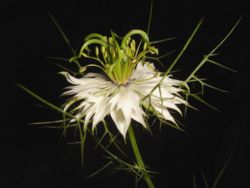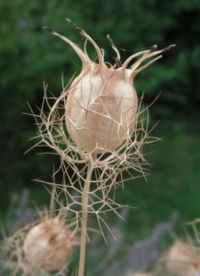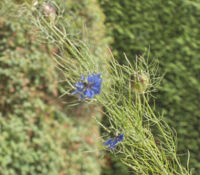Nigella damascena
| Nigella damascena subsp. var. | ||||||||||||||||||||||||||||||||||||||||||||||||||||||||
|---|---|---|---|---|---|---|---|---|---|---|---|---|---|---|---|---|---|---|---|---|---|---|---|---|---|---|---|---|---|---|---|---|---|---|---|---|---|---|---|---|---|---|---|---|---|---|---|---|---|---|---|---|---|---|---|---|

|
|
| ||||||||||||||||||||||||||||||||||||||||||||||||||||||
| ||||||||||||||||||||||||||||||||||||||||||||||||||||||||
| Standard Cyclopedia of Horticulture |
|---|
|
Nigella damascena, Linn. Fig. 2482. Height 1-2 ft.: Lvs. bright green, very finely cut: fls. white or blue, large; involucre very dense and fine; styles erect in the fr., nearly as long as the caps.: fr. not divergent at top. Summer. S. Eu. B.M. 22. Gn. 37, p. 130; 63, p. 165. J.H. III. 51:61. Gn.M. 5:296. Var. nana, Hort. A dwarf form with very large fls.
|
| Love-in-a-mist {{{status}}} Fossil range: {{{fossil_range}}}
| ||||||||||||||||||||||||||||||||||||||||||||||||||||||||||||||||||
|---|---|---|---|---|---|---|---|---|---|---|---|---|---|---|---|---|---|---|---|---|---|---|---|---|---|---|---|---|---|---|---|---|---|---|---|---|---|---|---|---|---|---|---|---|---|---|---|---|---|---|---|---|---|---|---|---|---|---|---|---|---|---|---|---|---|---|
 A white Nigella damascena | ||||||||||||||||||||||||||||||||||||||||||||||||||||||||||||||||||
| Plant Info | ||||||||||||||||||||||||||||||||||||||||||||||||||||||||||||||||||
| ||||||||||||||||||||||||||||||||||||||||||||||||||||||||||||||||||
| Scientific classification | ||||||||||||||||||||||||||||||||||||||||||||||||||||||||||||||||||
| ||||||||||||||||||||||||||||||||||||||||||||||||||||||||||||||||||
| [[{{{diversity_link}}}|Diversity]] | ||||||||||||||||||||||||||||||||||||||||||||||||||||||||||||||||||
| {{{diversity}}} | ||||||||||||||||||||||||||||||||||||||||||||||||||||||||||||||||||
| Binomial name | ||||||||||||||||||||||||||||||||||||||||||||||||||||||||||||||||||
| Nigella damascena L. | ||||||||||||||||||||||||||||||||||||||||||||||||||||||||||||||||||
| Trinomial name | ||||||||||||||||||||||||||||||||||||||||||||||||||||||||||||||||||
| {{{trinomial}}} | ||||||||||||||||||||||||||||||||||||||||||||||||||||||||||||||||||
| Type Species | ||||||||||||||||||||||||||||||||||||||||||||||||||||||||||||||||||
| {{{type_species}}} | ||||||||||||||||||||||||||||||||||||||||||||||||||||||||||||||||||
| {{{subdivision_ranks}}} | ||||||||||||||||||||||||||||||||||||||||||||||||||||||||||||||||||
| [[Image:{{{range_map}}}|{{{range_map_width}}}|]] | ||||||||||||||||||||||||||||||||||||||||||||||||||||||||||||||||||
| Synonyms | ||||||||||||||||||||||||||||||||||||||||||||||||||||||||||||||||||
| {{{synonyms}}} |

Nigella damascena (Love-in-a-mist) is an annual garden flowering plant, belonging to the buttercup family (Ranunculaceae).
It is native to southern Europe (but adventive in more northern countries of Europe), north Africa and southwest Asia. It is also commonly grown in gardens in North America. It is found on neglected, damp patches of land.
The plant's common name comes from the flower being nestled in a ring of multifid, lacy bracts. It's also sometimes called Devil in the Bush.
It grows to 20-50 cm tall, with pinnately divided, thread-like, alternate leaves.
The flowers are white, pink, pale blue or pale purple, with 5-10 sepals. The actual petals are located at the base of the stamens and are minute and clawed. The sepals are the only colored part of the perianth. The 4-5 carpels of the compound pistil have each an erect style. The flowers blossom in May and June.
The fruit is a large and inflated capsule, growing from a compound ovary, and is composed of several united follicles, each containing numerous seeds. This is rather exceptional for a member of the buttercup family. The capsule becomes brown in late summer.
They are much used in dried flower bouquets.

There are several cultivars available with flowers in shades of pink and purple, including 'Albion', 'Blue Midget', 'Cambridge Blue', 'Miss Jekyll', 'Mulberry Rose', 'Oxford Blue' and 'Persian Jewels'.
Related Species
The related Nigella sativa (and not N. damascena) is the source of the spice variously known as Nigella, Kalonji or Black Cumin.